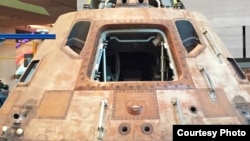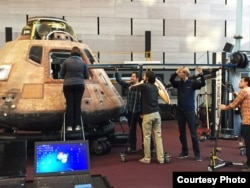In 1969, a stainless steel, titanium, and aluminum capsule was the outer space home for U.S. astronauts Neil Armstrong, Edwin "Buzz" Aldrin and Michael Collins when Armstrong and Aldrin became the first two humans to walk on the moon.
That Apollo 11 Command Module Columbia sits in the Smithsonian's Washington, D.C., Air and Space Museum. It is the only part of the spaceship that returned to earth.
Soon, you will be able to see Columbia on your personal computer. Or, your smartphone.
Columbia - a Digital Exhibit
Digital specialists are scanning the inside of the module to create an online model.
Through their scans and photographs, computer users can see outer space the way the astronauts did, as if sitting in their seats.
The user can also print a 3-D replica of the module. Experts say anyone can make a life-sized model from the digital information, but they expect most people to construct scaled down models of the 320 x 400 cm (11'x13') artifact.
Specialists are using special 3-D technology to scan the interior, but they are not allowed to touch or climb inside the module, which is dubbed a "Milestone of Flight" by the Smithsonian. They use 5DSR cameras on extended arms that deliver 50 megapixel photographs.
Those thousands of pictures will be combined with 50 laser scans that ingest one million points to produce 6GB of data. The images are loaded into software that allows the user to turn and probe the module on a computer monitor, giving the ability to see the capsule inside and out.
3-D Uncovers Surprises
The Smithsonian says 3-D technology tells the story of its collections in ways that can't be done in museum visits. It also reveals information that even the curators haven’t seen.
"With the Command Module, no one has been inside since it came into the collection," says Adam Metallo, Smithsonian 3-D imaging specialist. "Now the information we capture can give anyone in the world a view of what it looks like inside this incredible piece of history.”
Watch the scanning work taking place at the Smithsonian's Air and Space Museum. Experts are not permitted inside the module, so they use robotic cameras on extended poles.
The Smithsonian is partnering with California-based Autodesk for the intricate project. "Autodesk built the interactive 3-D viewer exclusively for Smithsonian use," says Paul Sullivan Autodesk's Tech Trends Evangelist.
"The 3-D technology is revolutionizing museums the same way it has revolutionized architecture, engineering, gaming, and Hollywood, and the Smithsonian aims to be at the forefront of this transformation," continues Sullivan.
More 3D: Buddha and Wright Flyer
Autodesk also assisted with the 3-D display of Cosmic Buddha, which Smithsonian curators say is one of its top ten exhibits. The scan allowed the first-ever reading of what was on the Buddha sculpture, an insight into ancient Chinese art narratives.
The same 3-D scanning was completed on the 1903 Wright Flyer. Wilbur and Orville Wright are credited with being first successful pilots in flying machines that ushered in the Age of Aviation. The Wright Flyer on display at the Air and Space Museum is a version of the plane that made the astonishing journey of 255 meters (850 feet) in 59 seconds.
The Apollo 11 command module will be the focal point of a new display at the Smithsonian Air and Space Museum entitled Destination Moon. It opens in 2020. The virtual model will be available on line by the middle of 2016.











